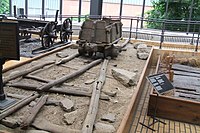Permanent way (history)

The permanent way is a term used to describe the railway tracks, sleepers, and ballast that provide a stable foundation for trains to travel on. A long, long time ago, when trains were first invented, tracks were just made of wooden boards that would often break and warp. Trains would also leave ruts in the ground, and derailments were common.
The solution to this problem was to use iron tracks, which were much more durable, and could withstand the weight of the trains better than wooden tracks. In the 19th century, many different designs of iron tracks were tested, and it was found that the best design was a straight, flat, and level track called the "permanent way".
The permanent way was made up of rails that were laid parallel to one another, and held in place by sleepers (also known as ties in some parts of the world), which were positioned perpendicular to the rails. The space between the sleepers was filled with a layer of rocks, called ballast. This design created a stable foundation for the tracks, and prevented them from shifting or derailing.
In the early days of rail travel, the permanent way was made entirely of iron, but as technology improved, steel tracks became the norm. Today, modern railways still use the same basic design for their permanent way, with some additional features like electrification, signaling, and safety systems. The permanent way is an essential part of our rail networks, and it all started with the simple idea of making tracks that would stay in place.
The solution to this problem was to use iron tracks, which were much more durable, and could withstand the weight of the trains better than wooden tracks. In the 19th century, many different designs of iron tracks were tested, and it was found that the best design was a straight, flat, and level track called the "permanent way".
The permanent way was made up of rails that were laid parallel to one another, and held in place by sleepers (also known as ties in some parts of the world), which were positioned perpendicular to the rails. The space between the sleepers was filled with a layer of rocks, called ballast. This design created a stable foundation for the tracks, and prevented them from shifting or derailing.
In the early days of rail travel, the permanent way was made entirely of iron, but as technology improved, steel tracks became the norm. Today, modern railways still use the same basic design for their permanent way, with some additional features like electrification, signaling, and safety systems. The permanent way is an essential part of our rail networks, and it all started with the simple idea of making tracks that would stay in place.
Related topics others have asked about:
